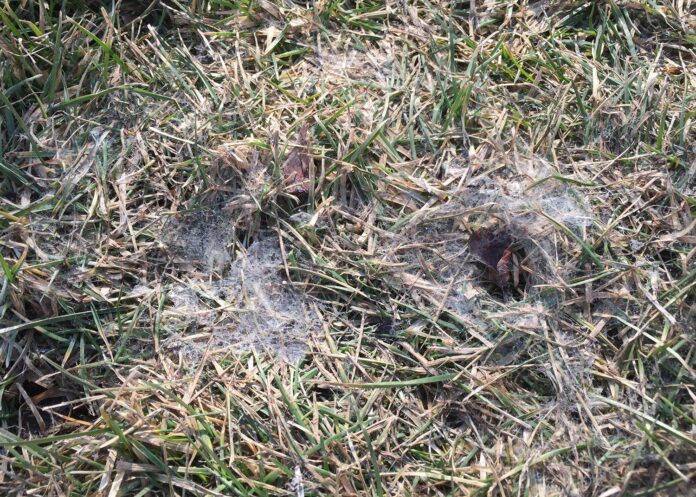
As winter gives way to spring take a walk around the yard. Check the lawn for damage and provide a bit of early season care to help it recover from winter.
Use a leaf rake to lightly lift and separate the matted grass blades. This helps speed drying, increase airflow, and reduce the risk of pink and gray snow mold developing and damaging your lawn.
These fungal diseases are most common when heavy snowfalls or ice covers non-frozen turf or after late winter snowstorms. The damage is usually seen where snow lingers late in the season.
Symptoms appear as circular areas of matted brown grass. You may even see a gray or pink cobweb-like growth over these areas. Fortunately, lawns eventually recover. Reduce the risk of future problems with proper timing of lawn fertilization.
Remove any leaves or debris that ended up on the lawn. Large leaves on the grass capture moisture and prevent sunlight from reaching the plants below. Use leaves you collect as mulch in the garden or add to the compost pile.
Look for vole trails in the lawn. These small rodents travel beneath the snow and over the grass in search of food all winter long. Their travels create trails of bare or dead grass. The surrounding grass will eventually fill in the damaged areas. Speed recovery by sprinkling grass seed over the trails. Just mix a handful of grass seed in a mop bucket of topsoil to make a lawn patch. Sprinkle the mixture in the trails, gently tamp and water.
Check areas along walks, drives and the street for deicing salt damage. Even if you don’t apply deicing salts, passing cars can spray it onto your lawn. Your car also brings home salt as it travels along salted roadways, depositing salty snow onto the drive.
Make sure these areas receive sufficient water this spring. Regular spring showers often do the job. Thoroughly water these areas during dry springtime weather to help wash the salt past the grass roots into the soil below. Consider shoveling first and using plant-friendly deicing salts in the future. This will reduce the need for deicing salts and reduce the time and money spent repairing salt-damaged plants.
Use this time to sharpen your mower blades. Using sharp blades to cut the grass results in a healthier and better-looking lawn. The clean cut made by a sharp blade closes quickly, reducing the risk of disease problems. Sharp blades also save time as you can cut the grass more efficiently. And speaking of savings, your mower will consume 22% less fuel and the lawn will use up to 30% less water when using sharp blades.
Soon it will be time to mow the lawn. Mow high and often, leaving grass clippings on the lawn to add organic matter, moisture, and nutrients to the soil. Always sweep clippings off walks and the drive to keep this valuable organic matter out of waterways.
Take care of winter damage now before the even busier garden season begins. Investing time now helps improve your lawn’s health and beauty, allowing you more time to enjoy the summer.














